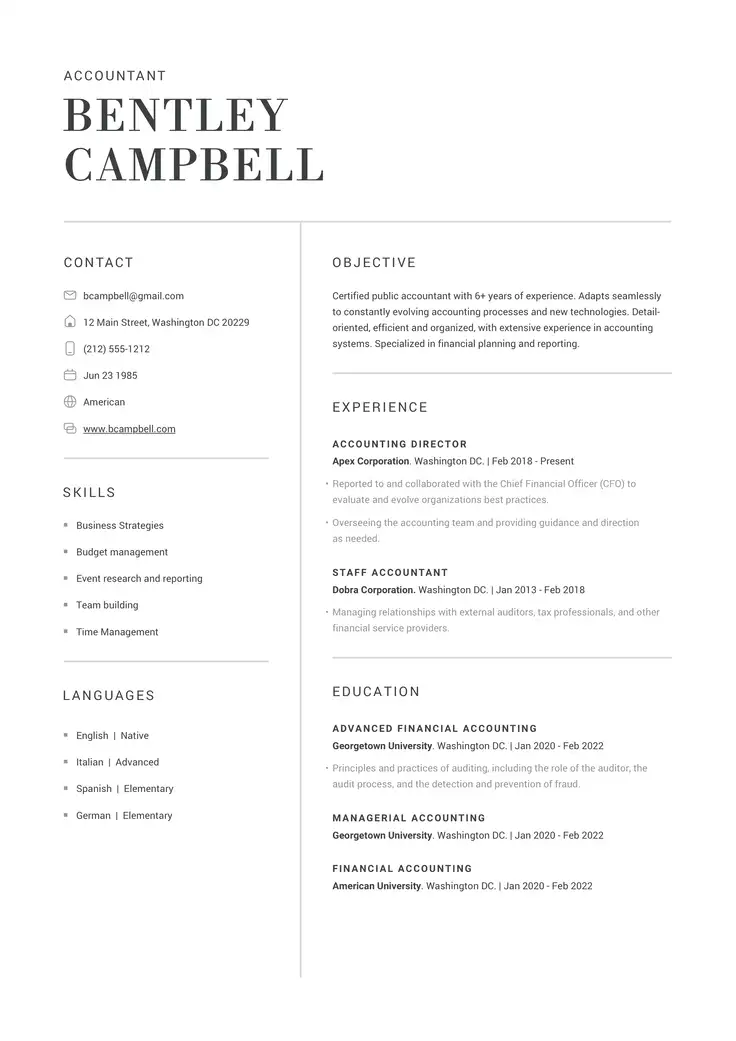The population and workforce of America are aging, with many older adults still working. Others are ‘unretiring,’ that is, returning to work after having retired.
If you’re among this growing sector of the workforce, you may be wondering what can help you succeed in finding a job.
Whether changing roles or re-entering the workforce as an older adult, a well-written, modern resume is a key tool to overcoming age-related bias and highlighting your value. You’ll find out that you can successfully change your career at any age.
However, while resume-writing can be difficult at any age, the AARP reports that six in ten workers aged 50 and older have seen or experienced age discrimination. This can add to your concerns when writing your job application as a senior worker.
Below, we’ll help you discover the tools, like our AI resume builder, and skills you need to avoid age-related bias, modernize your resume, and let your skills and experience shine.
Modernize Your Resume Format
The Pew Research Center reports that workers aged 75 and older “are the fastest-growing age group in the workforce, more than quadrupling in size since 1964.”
If you are part of that group and haven’t had to apply in a long time, it’s a good idea to modernize how your resume is formatted.
In many ways, resumes for seniors returning to work are very similar to any other. You should use a clean, up-to-date design that is easy to read and is suitable for ATS software to scan. This Applicant Tracking System is software that employers use to filter, rank, and organize the resumes they receive.
Most recruiters expect resumes to be in reverse chronological format, listing experiences from the most recent to the oldest. This style of resume is also suitable for showcasing extensive experience in a relatively small space, as a resume should be limited to 2 pages.
Start with a resume summary instead of an objective
In the past, you may have included a resume objective or objective statement at the top of your resume. This short paragraph outlined your career goals, how what you wanted aligned with what the company wanted.
In 2025, recruiters want to see a resume summary, a statement summarizing your qualifications and achievements.
What does a resume summary look like? Consider the following example.
Summary
Operations leader with 20+ years of experience streamlining logistics, reducing costs, and driving efficiency across global supply chains. Recently updated skills with certification in cloud-based inventory systems.
You can use ResumeCoach’s AI resume summary generator to help you write yours if your mind has drawn a blank!
Place your skills high up on the page
Another modern trend involves placing your skills section immediately after the summary, before listing your experience. This highlights your abilities right away, which is particularly effective for today’s skills-based hiring.
Think about it this way: the higher your skills are on the page, the more likely they are to be read.
In fact, studies have shown that people’s eyes often scan the page in the shape of the letter “F.” Imagine a large letter “F” stamped across your resume—your skills should fall between the horizontal lines of that letter!
If your skills are strong and catch the hiring manager’s attention, they will be more likely to spend time reading the rest of your resume.
Don’t Include This Outdated Info
There are several resume sections and pieces of information that are no longer required on your resume. Check your resume for the following items to avoid.
Your home address
This is no longer considered necessary, as it can even pose a security threat or lead to discrimination based on where you live. Include only your city/state and add (Remote) at the end if you are looking for remote roles.
A references section or the phrase “References available upon request.”
This takes up space that could be used to demonstrate more skills and experience. Your employer knows they can request this information if needed.
An objective statement
This introductory statement is considered outdated because it focuses on what you want rather than what you can offer the recruiter.
Land or fax numbers
A fax number, landline or home phone number, or an outdated email provider such as AOL, are considered out of date. It would be better to include your mobile number or your LinkedIn profile.
Be Selective With Your Work History
The above can keep your resume from appearing dated, but there is another common mistake you should watch out for. Including information that could reveal your age could put you on the receiving end of age-related bias.
Remember that no matter how long and impressive your career has been, recruiters only need to see what is most relevant today. This checklist will help you refine your experience section, allowing recruiters to focus on your abilities rather than your physical age.
- Include only jobs from the last 10 to 15 years of experience unless earlier roles are directly relevant to the position you’re applying for.
- Avoid listing every role in long tenures and combine similar positions if necessary. This also helps avoid redundancy.
- Leave out early-career roles that are unrelated and add no value, for example, a temp job from the 1980s.
Here’s an example of how you might do this.
Instead of listing four separate roles at the same company:
Wrong ❌
Sales Associate (2006–2008), Senior Sales Associate (2008–2012), Sales Manager (2012–2019), Regional Manager (2019–2024)
Condense them into one entry:
Right ✅
Company XYZ,
2006–2024
Progressed from Sales Associate to Regional Manager, overseeing multi-state sales operations and mentoring 50+ employees
Leave out dates in your Education section
When writing about your education, you don’t have to include your college graduation date or dates. You should list your degree or certification titles in reverse chronological order.
Education
University of California, Berkeley, CA
Master of Business Administration
Stanford University, Palo Alto, CA
Bachelor of Science in Computer Science
Highlight Skills and Accomplishments Over Chronology
On modern resumes, skills and accomplishments should be front and center. This development is beneficial for older workers who want to avoid drawing attention to their age
Create accomplishment-based resume sections
Instead of presenting your career as a timeline, consider grouping selected accomplishments by expertise. You might use headings such as Leadership & Strategy, Client Success, Process Improvement, or Technology & Systems.
Leadership & Strategy
- Spearheaded company-wide cost-reduction initiative that saved $1.2M annually.
- Mentored and promoted 15+ team members into management roles.
Emphasize the skills relevant to the job
Today’s skills-based hiring trend places less emphasis on degrees or your specific educational experiences, and more on proof that you have the abilities needed to do the job. You’ll need to make sure these make it onto your resume. How do you know what skills to include?
First, find out what skills are most needed in and relevant to your field. One way of doing this is by scouring job postings for potential resume keywords. Alternatively, you can use an AI resume skills generator to create a list of skills tailored to your desired job.
Either way, you should make sure the exact word or phrase is used in your resume. If a posting asks for “digital literacy” or “team leadership,” make sure these appear in your skills or bullet points.
Modern employers value both technical skills and people skills.
💡Tip
Most jobs now require basic computer skills such as CRM software, POS systems, Microsoft Office, or project management tools.
An advantage for older workers is that soft skills are still highly sought-after. These include qualities that you’ve likely developed throughout a lifetime of working. They include interpersonal skills, problem-solving and critical thinking abilities, communication skills, teamwork, and leadership, among others.
Don’t just list these skills, but show them in action within your bullet point descriptions.
Use strong action verbs and quantify results
Over the years, you have developed many skills and had lots of experiences that have shaped you into a well-rounded employee who can have a positive impact on the workplace.
You must remember this even if you have doubts about how competitive your skills and experience are.
You can overcome such fears when your resume bullet points are solid, backed by details of the actions you took and their results.
Remember, hiring managers want to see impact. Start your bullet points with strong verbs and add numbers, positive results, or things you learned from the experience wherever possible.
Take a look at the following table to see examples of how to emphasize your achievements.
| Action verbs | Emphasis on data | Emphasis on quality |
|---|---|---|
| Launched | Percent increase / decrease | Recognition from leadership or clients |
| Transformed | Dollar amount saved | Positive customer feedback |
| Optimized | Number of people supervised | Improved user experience |
Consider an example of this in action.
Wrong ❌
Responsible for managing the supply chain.
The above example does not include any qualitative or quantitative information to impress the recruiter, despite using the action verb ‘managing’.
Right ✅
Streamlined supply chain processes, reducing shipping delays by 35% and saving $200K annually.
Stay digitally relevant
Even outside the tech industry, you need to demonstrate some level of proficiency with digital technology.
First, you can establish a digital presence by creating a LinkedIn account. LinkedIn is an online professional network you can use to stay connected with coworkers, colleagues, and leaders in your field. Setting up your profile is easy; you can use the resume you’ve just perfected to fill in each section.
Next, you should stay active on the platform. You can do this by following organizations or topics you’re interested in, commenting meaningfully on others’ posts, and creating your own posts.
Don’t know what to post about? Share a link to an article you found interesting with your thoughts on it, let others know you’re looking for a job, or share an inspiring experience or a teaching moment. You can even write articles and publish them on LinkedIn.
LinkedIn will prompt you to post an update when you add a new skill or certification. This, too, will help you stay digitally relevant. If there’s a new or changing technology that’s important to your work, you can upskill by taking classes through LinkedIn Learning, Coursera, or Google Certificates.
How to Address ‘Unretiring’ and Career Gaps
“Unretiring” is a growing trend. According to the Pew report mentioned earlier, nearly one in five U.S. retirees eventually return to work. Some are motivated by the need for financial stability, while others seek purpose or social connection.
If you are re-entering the workforce after retirement, you can address your decision and resulting career gaps in the following ways.
- Be transparent yet positive. Briefly mention your career break in your cover letter or summary.
- Frame it as growth. Emphasize renewed energy and purpose, community involvement, or relevant training such as certifications you’ve obtained.
- Include recent activity. Consulting, volunteering, or freelance work count as relevant experience.
- Consider including a “Career Break” section if needed.
Here’s an example of how you can do that:
Experience
Career Break (2019–2023)
Focused on family care responsibilities and personal development. Completed courses in digital marketing and project management. Volunteered as Treasurer for a local nonprofit.
What about including it in your summary? Here’s an example professional summary for an unretiring worker:
Summary
Customer-focused professional re-entering the workforce after a fulfilling early retirement. Brings 25+ years of experience in retail leadership, team building, and sales growth. Recent training in digital POS systems and customer service strategies.
Key Takeaways
Experience is an asset, not a liability—but how you present it matters. With the right structure, your resume will highlight your strengths while minimizing any age-related bias.
Remember to:
- Keep your format modern, concise, and ATS-friendly.
- Focus on the last 10 to 15 years of relevant work experience.
- Highlight skills, accomplishments, and results rather than lengthy tenures or job histories.
- Leave out the dates in your education
- Stay digitally relevant by maintaining a LinkedIn profile and upskilling.
- Address retirement breaks with confidence, asserting that you bring a renewed focus and up-to-date skills to the table.
If you still need help with your resume, remember that you can use our AI tools to help you write your resume.
Your knowledge and experience are valuable. With a well-written, updated resume, you can step confidently into the next stage in your career.
FAQs
When returning to the workforce, you should try to focus on the value you can bring today, not only your full career history.
Remember to highlight recent volunteer work, consulting projects, or part-time roles that show you remain active and relevant. Emphasize transferable skills, such as leadership, problem-solving, or mentoring, that match the role you want.
Keep your resume concise, ideally no more than two pages, and tailor it to the industry you’re targeting.
If you would like to avoid drawing attention to your age, leave out graduation dates and early job roles that are not relevant to your target position.
Focus on the past 10–15 years of experience to highlight your accomplishments instead of just including a long timeline.
Also, take advantage of a modern resume design with clean fonts and avoid outdated formats like objectives. Highlight current skills, especially in technology and industry-specific tools, to show you’re up-to-date.
A reverse chronological format is often a perfect choice for not only retired professionals reentering the workforce, but just about any jobseeker.
This layout clearly presents your most recent roles first, making it easy for employers to see all of your accomplishments and relevant experience. It also highlights your professional growth, which can reassure hiring managers.
Related Posts


